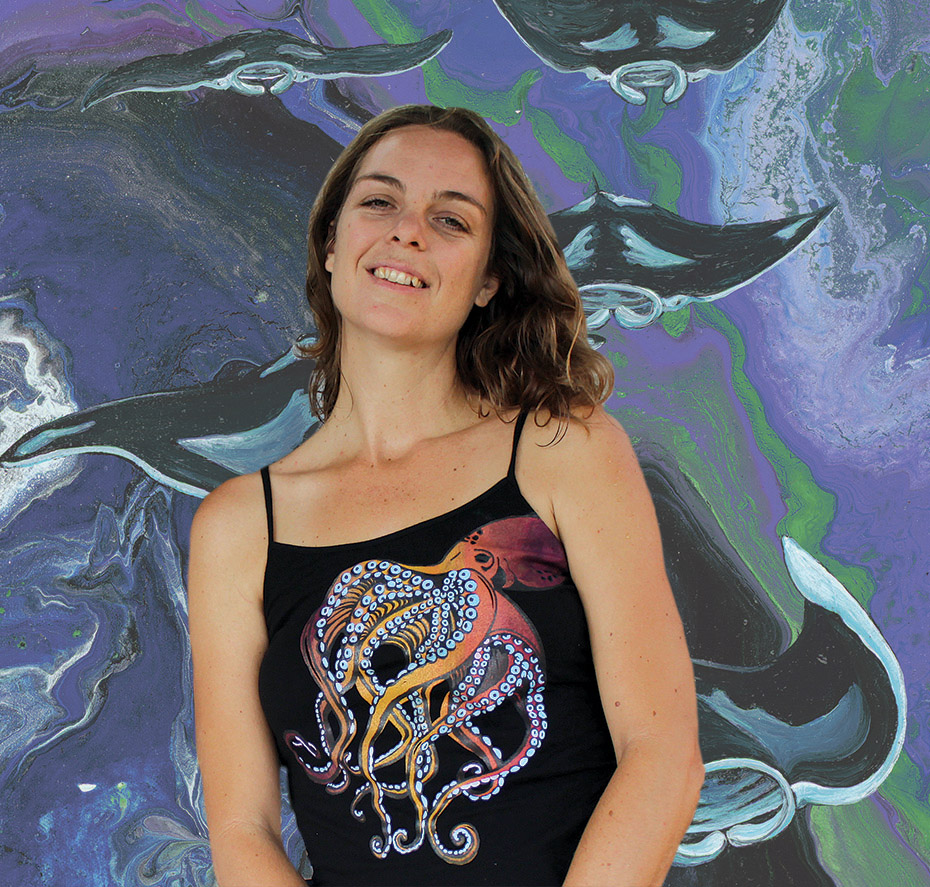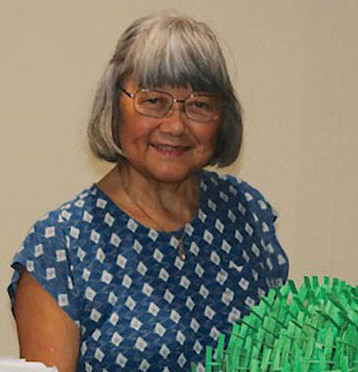
Iris Viacrusis: Creating Fashion from Paris to Paradise
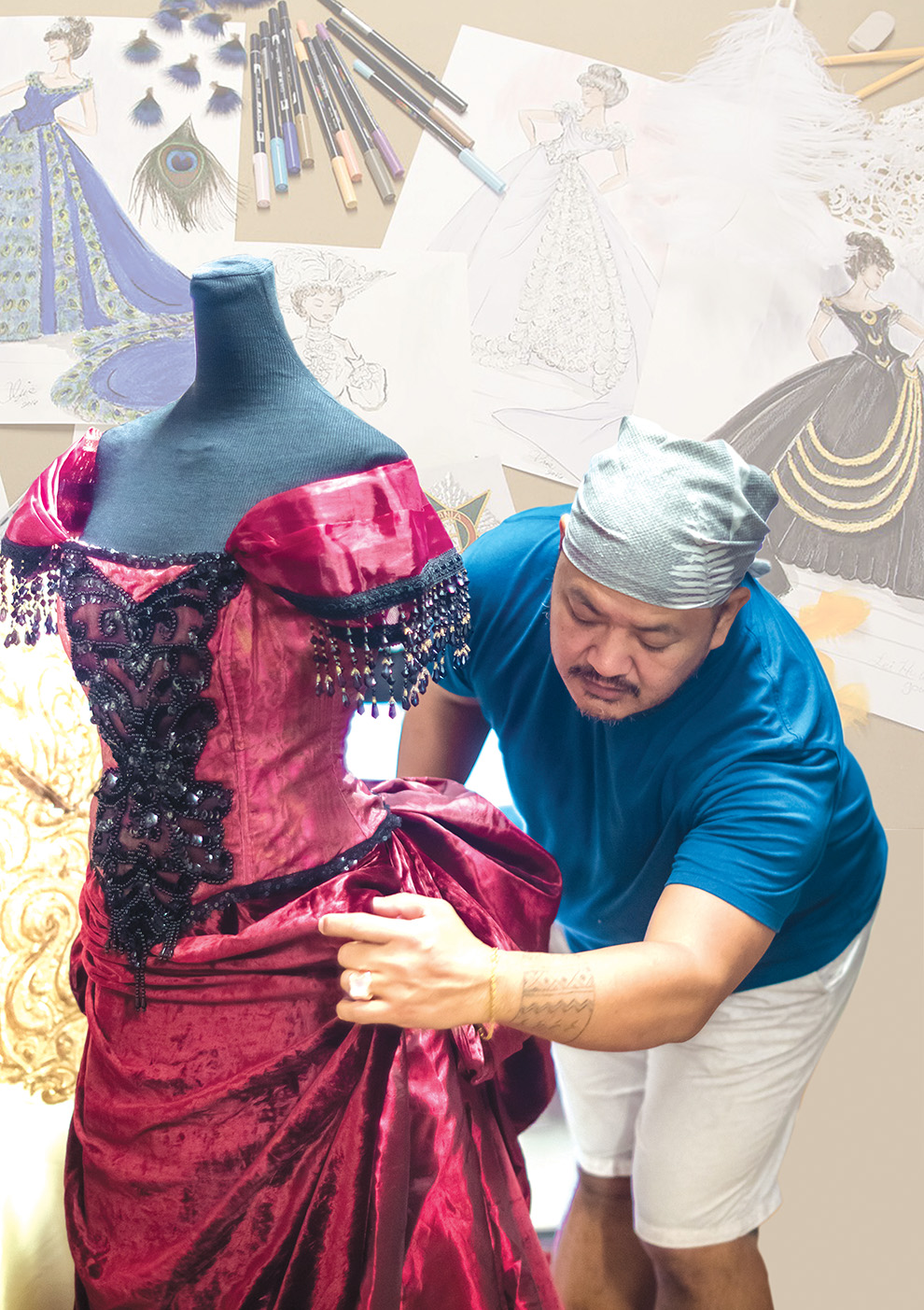
By Mālielani Larish
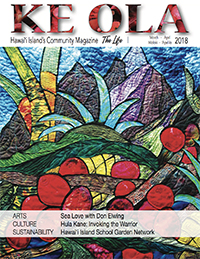
Dressed in a velvet azure gown made by Hawai‘i Island fashion designer Iris Viacrusis, and adorned with a peacock feather collar that she had handcrafted herself, Aunty Doreen Henderson graced the 2013 Merrie Monarch stage with an air of royalty. Aunty Doreen had made her debut as the event’s first queen 50 years earlier. Beaming proudly, Iris escorted Aunty Doreen across the stage, wearing a traditional piña fiber tunic as a tribute to his Filipino heritage.
Exhausted, but happy that he had contributed to several projects for the Merrie Monarch’s 50th Anniversary, Iris whispered to Aunty Doreen jokingly, “I think you need to hold me up.”
Three years later, Aunty Doreen would support Iris in creating his crowning achievement to date, the regalia of the ‘Iolani Palace’s Ali‘i Gown Reproduction Project. In addition, Iris has catalyzed local interest in Filipino culture and the traditional attire of the Philippines. He also worked as the wardrobe designer for a film entitled The Islands (which will premiere in November 2018). A series of serendipitous events have enabled Iris to stay true to his dream of creating ultra-classic, ultra-feminine, one-of-a-kind works of fashion.
From the Philippines to Paris
Born in Olongapo City in the Philippines, Iris moved to San Jose, California at age 13. From the first peach dress that he created for a beloved doll, Iris recalls immersing himself in the creative process at a young age. He studied business administration and fashion, and moved to Los Angeles in 1998 in the hopes of infiltrating Hollywood’s fashion scene. Alas, Iris realized that the industry had changed and no longer needed skilled designers. He found that modern productions often hire stylists who rent costumes or pull costumes out of archives.
Still passionate about creating fashion from drawing board to finished work of art, Iris decided to settle in Paris in 2001, where he hoped to study at the same school that his admired mentors, such as Valentino, had graduated from. After being turned down several times due to his limited French speaking skills, Iris was finally admitted to L’École de la Chambre Syndicale de la Couture and earned a special certificate from the institution. This certificate served as Iris’ ticket to Paris’ realm of haute couture (high fashion). He landed a position with American designer Abraham Pellem and designed a personal collection for an interpreter from Geneva. Later, he found work at Paris’ premier weaving company, Malhia Kent Fabric Design House. When his textile designs were selected to appear in fashion shows for the likes of Christian Dior and Chanel, the owner of the company gave him tickets to the show.

“I lived the Bohemian lifestyle,” Iris says, recalling his closet-like living quarters with a grin. After three and a half years surviving on minimal pay in Paris, Iris decided to return to the US.
He soon found work in Dallas, Texas, where he designed and installed draperies and curtains for the nouveau riche. “It got lucrative, but it wasn’t fitting nicely,” Iris says.
When Iris moved to Hawai‘i Island in 2005 to rescue a property that his father wanted to sell, he allowed his design career to hibernate. In the fertile jungle of Hawaiian Paradise Park, Iris cultivated a plant nursery business with his partner and channeled his creative instincts into designing the Hilo Orchid Society’s display for its annual sale.
The universe, however, blessed Iris with a gift that reawakened his designing career. After one of Iris’ friends was diagnosed with breast cancer, he spent six months as her caregiver. Her husband insisted that they repay Iris with a meaningful gift. When they found out about Iris’ latent talents, they funded the conversion of his carport into the design studio that he still uses today.
Fast-forward to 2009, while attending a presentation at the Lyman Museum, Iris was introduced to Aunty Doreen Henderson, a respected kumu (teacher) of lei hulu (featherwork). Iris asked her what she was planning to wear for the Merrie Monarch’s 50th Anniversary event.
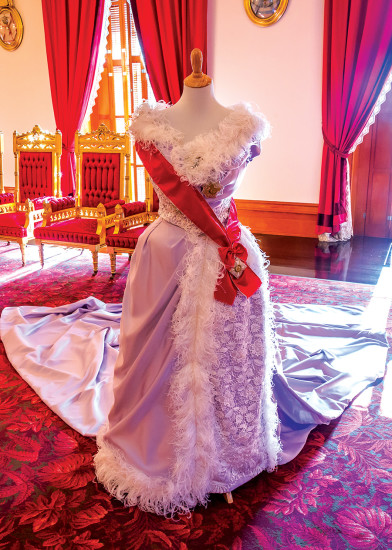
“They want me to wear my original dress!” Doreen replied. “You can’t do that!” Iris said. “It would be an honor for me to make you a dress…what color do you want?” Without hesitation, Doreen said “Peacock! I’ve always wanted to do a peacock collar for a dress.” Iris smiled. “I have the perfect fabric for you,” he said.
Iris’ role in creating Aunty Doreen’s dress launched his partnership with the Merrie Monarch Festival. For the 50th anniversary event, Iris created a new wardrobe for those who portrayed Queen Kapi‘olani, Queen Lili‘uokalani, Princess Likelike, and Princess Ka‘iulani in special appearances. He also designed and created the dresses for Kumu Hula Etua Lopes’ hālau (hula school), including Etua’s kupuna (elder) solo and his kūpuna dancers, along with the keiki (children) and wahine (women’s) groups.
Iris continued to bring his passion to Hilo’s beloved hula festival by leading the effort to bring the Los Angeles-based dance troupe Kayamanan Ng Lahi Philippine Folk Arts to the Merrie Monarch stage for the 2015 Ho‘ike, marking the first time that a Filipino performing arts group graced the Merrie Monarch stage. The performance exposed the audience to the cultural diversity of the Philippines and inspired pride in Filipino heritage. (The Philippines is home to 7000 islands and 118 indigenous groups.) In 2016 and 2017, Iris paved the way for another group, Parangal Dance Company, to represent Filipino culture at the Merrie Monarch Festival.
Iris notes that several of the kumu hula who compete at Merrie Monarch have Filipino heritage and that his goal is to highlight and celebrate the Filipino culture in hopes that it may flourish.
With a grant from the Hawai‘i Tourism Authority and the Atherton Foundation, Iris traveled throughout the Philippines to collect traditional costumes and textiles over a three-year period. He has shared this collection and given presentations about it on several islands. He also visited New York to deliver a presentation to the Filipino American National Historical Society and organized Hilo’s first annual Sakada Day to celebrate the arrival of Filipinos in the Hawaiian Islands. Iris has also served as a mentor for University of Hawai‘i at Hilo’s Bayanihan Club.
The Ali‘i Gown Reproduction Project at ‘Iolani Palace
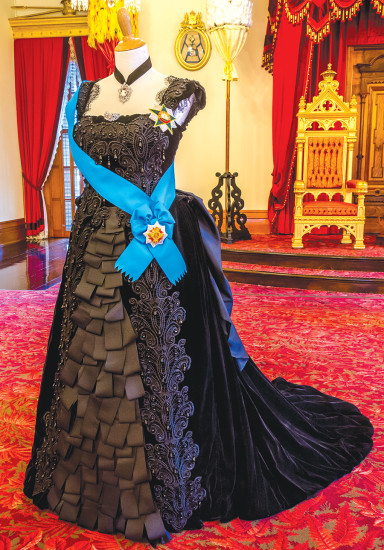
With a mannequin as his blank canvas, Iris assembles the Victorian-era bustle dress that helped initiate his partnership with the ‘Iolani Palace. Evoking the prevailing tastes of the year 1875, the dress is comprised of a foundational skirt, an overskirt that consists of a front apron, back pouf panel, and a bodice. The multi-layered effect is sumptuous: in the front, the wine-red velvet drapes down in concentric rings, like a symmetrical pahoehoe lava flow. In the back, Iris pulls the fabric up and out from the waist to create a luxurious cascade that accentuates the derrière. Intricate black lace and beadwork grace the front and sleeves of the bodice. This is the type of dress that Queen Emma would have worn, the monarch who reigned as Hawai‘i’s queen for 18 years before the future King David Kalākaua defeated her in a royal election.
Iris first created the dress for the YWCA’s 90th annual benefit show in 2009. When former Miss Hawai‘i Desiree Cruz donned the dress to perform the Queen’s song at ‘Iolani Palace’s annual fundraising event, the dress sparked the curiosity of then-curator Heather Diamond. Heather hoped to recreate the beloved gowns of the Ali‘i in an effort to attract more visitors to the palace, and after contacting Iris, she learned that his qualifications to assist with the project exceeded her expectations.
The magical coincidence is this: Iris studied Edwardian and Victorian costuming at Fullerton College in California, and the dresses worn by Hawai‘i’s regents come from this exact time period.
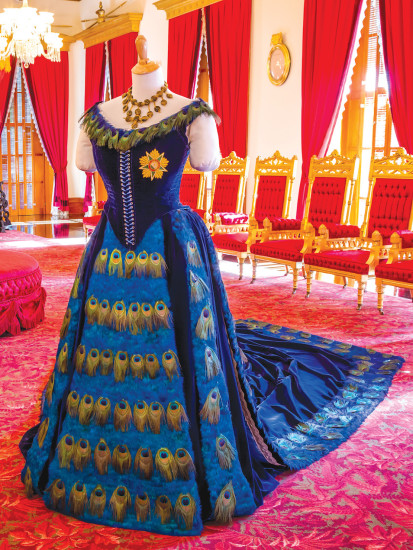
To recreate the gowns as authentically as possible, Iris became a historical detective for the project. He received permission from Bishop Museum’s curator, Betty Kam, to inspect remnants of the original gowns and peruse personal reminiscences of the Ali‘i. To take one example of his sharp eye for detail, he called attention to the fact that Queen Lili‘uokalani’s coronation gown was actually lilac in color. Iris found this by looking at the fabric hidden in the seams of the still-extant dress, which has otherwise faded to an ivory color. After reading a passage from Lili‘uokalani describing her favorite flower as the crown flower, Iris selected a fabric for the dress that captures the unique silver-lilac tone of the crown flower.
“If the king and queen were alive, this is what they would wear,” Iris says of the reproductions.
Of the first four gowns that Iris debuted for the project in 2016 and 2017, three represent gowns worn by Queen Kapi‘olani and her sister-in-law Lili‘uokalani to Queen Victoria’s Golden Jubilee in England. Queen Victoria requested that her guests wear fashion representing their culture, so Hawai‘i’s leading females chose to give their gowns a uniquely Hawaiian twist by incorporating featherwork. The first gown, Queen Kapi‘olani’s Lei Hulu gown, features the yellow feathers of the now-extinct ‘ō‘ō (black/yellow honey eater) bird. Iris believes that the feathers for the original gown were repurposed from old cloaks. In the reproduction of the gown, he used dyed goose feathers and combed them to mimic the wispy texture of ‘ō‘ō feathers.
Iris aptly calls Queen Kapi‘olani’s peacock feather gown, which took two years to complete, “the gown of my life.” Perhaps the most majestic of the collection, this azure gown features a train four yards long and peacock feather borders along two panels, the apron, the train, and the collar.
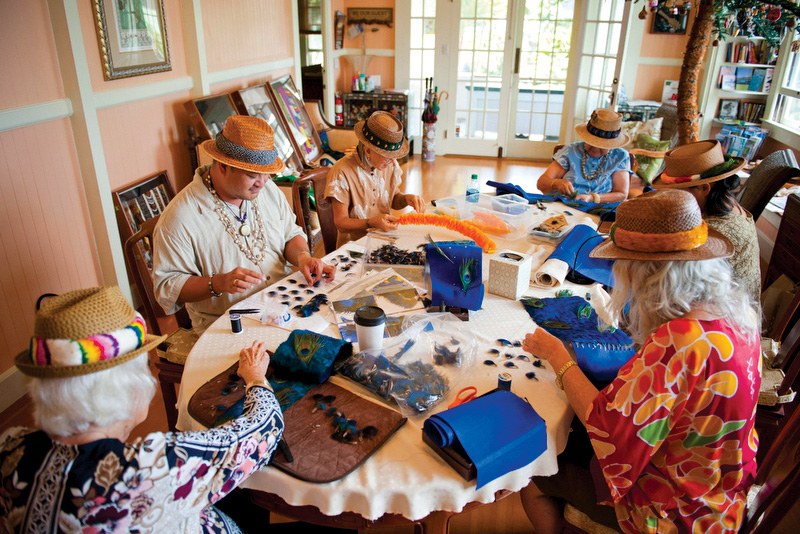
Iris partnered with Aunty Doreen Henderson for the project, who selected the crème de la crème of her Lei Hulu hui (club) to engage in the painstaking task of trimming and bundling peacock feathers, which must be stacked together to create a rich blue radiance. One Lei Hulu member, Noemi, even flew back and forth from Japan to help with the endeavor.
Some visitors to ‘Iolani Palace are moved to tears when they see the gowns. The dresses effectively embody the majesty of Hawai‘i’s royalty, who wore the gowns during the time when the Hawaiian nation was taken over by the United States.
Iris feels grateful and honored to have worked on the Ali‘i Gown Reproduction Project at the ‘Iolani Palace, and says that Aunty Doreen and her hui provided instrumental support for the endeavor. No matter what the future holds, Iris will continue to find ways to create, because for him, it is the creative process that brings him enduring joy. ❖
For more information: iviacrusis@yahoo.com; Facebook: Iris Viacrusis
